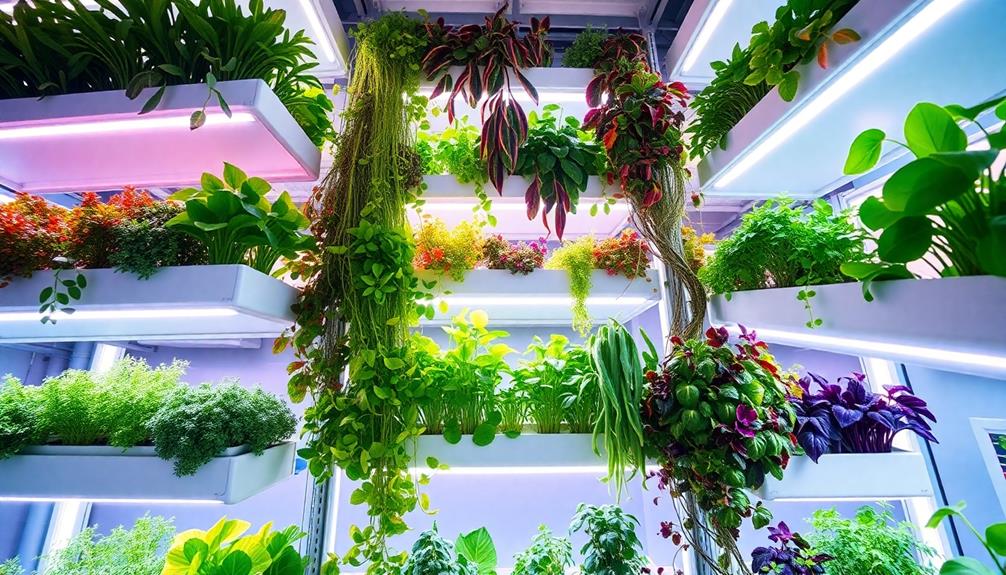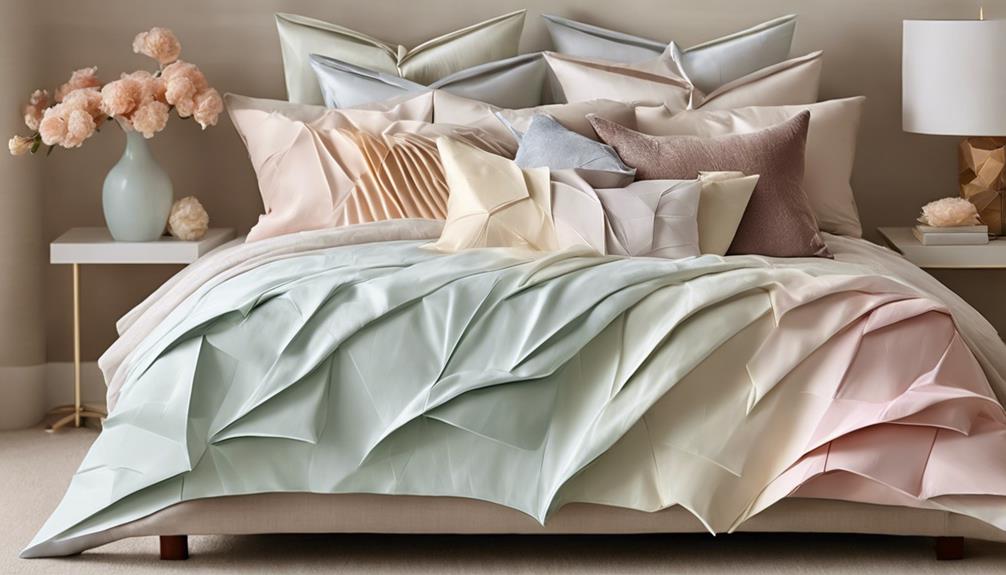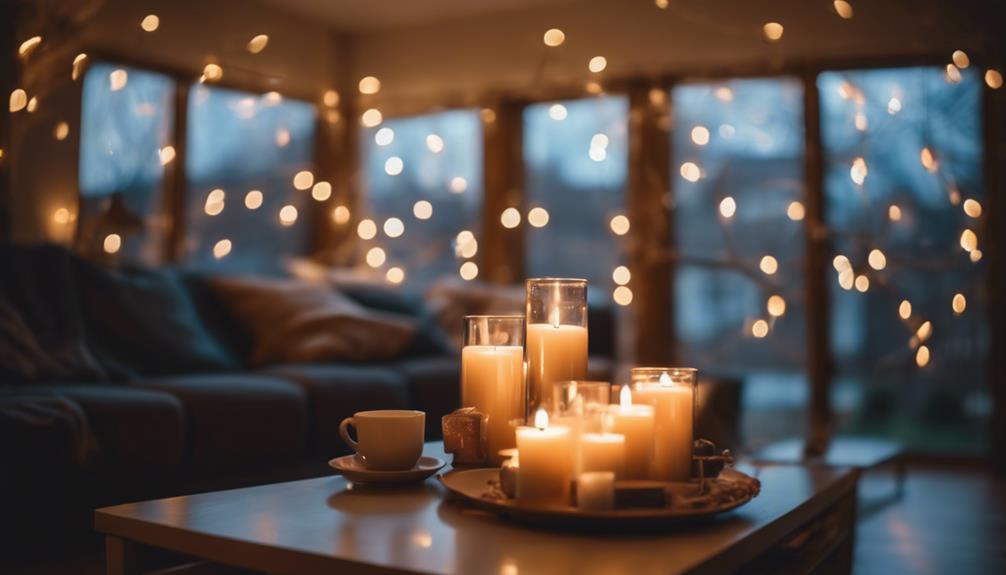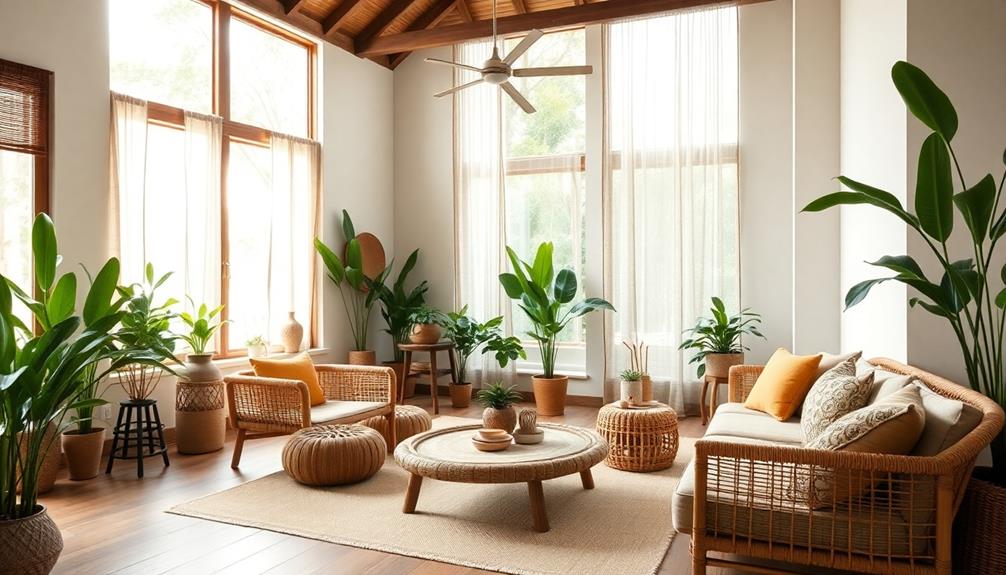Understanding Balinese design motifs in interiors is all about embracing nature and culture. You'll notice natural materials like wood, bamboo, and stone that add warmth and sustainability. Earthy tones paired with vibrant accents create a tranquil yet lively atmosphere. Intricate carvings tell stories and reflect the rich craftsmanship of Balinese artisans. Open-air spaces blur the lines between indoor and outdoor living, inviting serenity into your home. Incorporating traditional textiles and handcrafted decor enhances authenticity and meaning in your space. If you're curious about how to seamlessly integrate these elements, there's much more to explore on this enchanting design journey.
Key Takeaways
- Balinese design emphasizes natural materials like wood, stone, and bamboo, promoting warmth and sustainability in interiors.
- Earthy tones combined with vibrant accents create a calming yet energetic atmosphere in Balinese spaces.
- Intricate carvings reflecting mythological themes enhance the cultural significance and aesthetic appeal of interiors.
- Open-air spatial design connects indoor and outdoor environments, fostering natural ventilation and tranquility.
- Traditional textiles and handcrafted artifacts add depth and authenticity, celebrating Balinese craftsmanship and cultural heritage.
Overview of Balinese Design
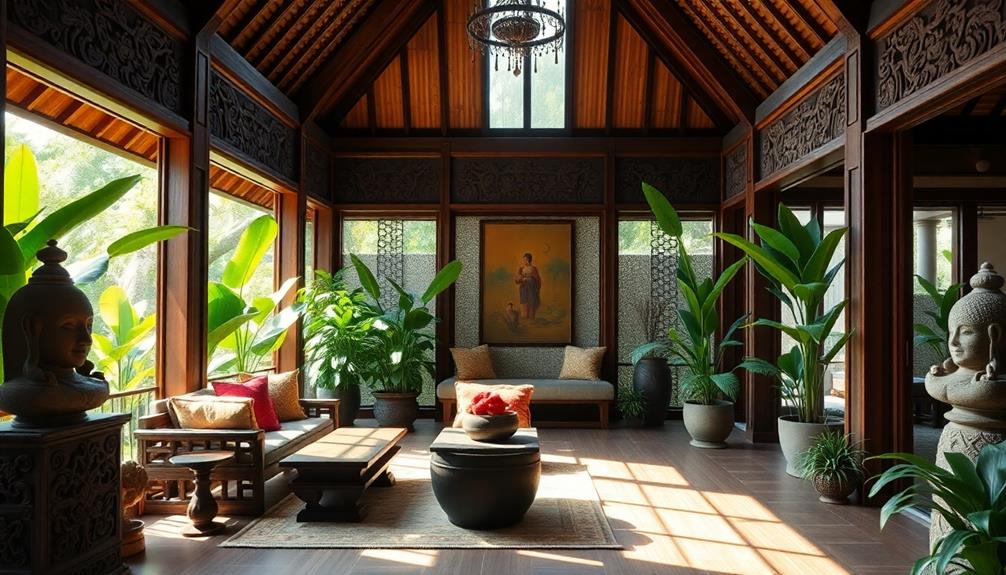
Balinese design draws you into a world where nature and artistry intertwine seamlessly. This interior design style emphasizes natural materials like wood, stone, and bamboo, creating a serene atmosphere that feels both luxurious and grounded.
You'll notice intricate carvings throughout, often depicting mythological themes and spiritual symbols that reflect the rich cultural heritage of Bali. The design often incorporates natural materials that enhance the overall aesthetic and sustainability of the space.
The color palettes in Balinese interiors typically feature earthy tones such as browns and greens, harmonizing beautifully with vibrant accents that mirror the lush surroundings. You can expect open-air spaces, a hallmark of Balinese design, which promotes a fluid connection between indoor and outdoor areas, enhancing airflow and natural light.
Decorative elements are thoughtfully curated, including traditional textiles and handcrafted artifacts that add depth and character. Lush greenery often finds its way into the design, further contributing to the tranquil ambiance.
Fundamentally, Balinese design creates an inviting sanctuary where you can escape the chaos of daily life and embrace a more serene existence. This enchanting blend of natural beauty and intricate craftsmanship makes Balinese interiors not just a style, but an experience to be savored.
Key Design Elements
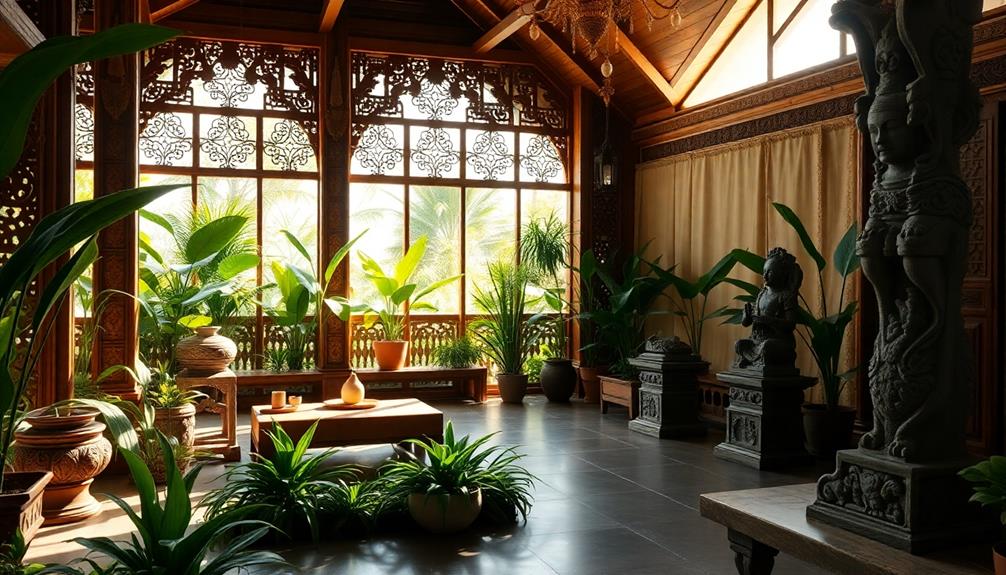
To create a true Balinese-inspired interior, you'll want to focus on natural materials, open-air designs, and traditional textiles.
Using elements like wood and stone not only adds warmth but also reflects the beauty of nature. Incorporating textiles like batik and ikat enhances the space with rich colors and patterns, making it feel authentically Balinese.
Additionally, consider adding Indonesian Decorative Pillows to your space, as they provide comfort while showcasing vibrant cultural heritage.
These design choices work together to create a serene and inviting ambiance that reflects Balinese principles of harmony.
Natural Material Utilization
In the heart of Balinese design, natural materials play a pivotal role in creating interiors that feel warm and inviting. You'll find that wood, particularly teak wood, is a fundamental element, often crafted into stunning Balinese furniture. These pieces aren't just functional; they showcase intricate carvings that reflect the island's rich cultural heritage.
Additionally, incorporating vibrant colors along with earthy tones can elevate the aesthetic appeal, creating a harmonious balance within your space. Bali interior design ideas often highlight this vibrant mix.
Bamboo also plays a significant role, serving as a structural element while emphasizing sustainability. Its versatility allows it to be used for everything from decorative items to functional components, reinforcing your connection to nature.
Stone accents, like volcanic rock and river stone, enhance the tactile experience of your space, grounding your interiors in Bali's geographical beauty.
When you incorporate these natural materials, you promote a sense of harmony and balance. They invite a seamless flow between indoor and outdoor areas, creating open spaces that enhance airflow and light.
This integration of elements not only accentuates the aesthetic appeal but also embodies the essence of Balinese living. By embracing these materials, you'll cultivate an atmosphere that's not only visually stunning but also deeply connected to the natural world.
Open-Air Space Design
Emphasizing an open-air concept in your design creates a rejuvenating blend of indoor comfort and outdoor freedom. Open-air spaces in Balinese architecture blur the boundaries between indoor and outdoor environments, allowing for natural ventilation and abundant light.
To enhance this experience, consider designing with tropical villa plans that prioritize seamless indoor-outdoor flow. You'll want to incorporate large windows and sliding doors to maximize airflow and provide unobstructed views of your landscape.
Consider adding pavilions, or bale, to create separate open-air areas for relaxation and social gatherings. These structures enhance the communal aspect of your living spaces, making them perfect for entertaining friends and family.
Don't forget to include water features like ponds or fountains; they add to the tranquility of your environment, providing calming sounds and visual interest.
Using natural materials such as wood and bamboo in your open-air design will help maintain a cohesive aesthetic that reflects the surrounding nature. This choice promotes a harmonious atmosphere, making your space feel more integrated with its environment.
Traditional Textiles Integration
Traditional textiles are an essential element in Balinese interior design, infusing spaces with vibrant colors and intricate patterns that celebrate local culture. By incorporating traditional textiles like batik and ikat, you not only enhance the aesthetic but also connect with the cultural identity of Bali.
| Textile Type | Description |
|---|---|
| Batik | A wax-resist dyeing technique featuring motifs that tell stories or symbolize nature. |
| Ikat | A dyeing method where yarn is dyed before weaving, creating a unique blurred effect. |
| Cushions | Upholstered with vibrant fabrics, adding comfort and warmth to your space. |
| Wall Hangings | Decorative pieces that showcase local craftsmanship and artistry, enhancing visual interest. |
| Throws | Soft textiles that provide texture, warmth, and a touch of Balinese heritage. |
Using these textiles in your home not only brings a sense of warmth but also highlights the importance of local craftsmanship. Whether through cushions, throws, or wall hangings, traditional textiles play a functional and decorative role, making them indispensable in modern Balinese interior design. Embrace these elements to create a rich, inviting atmosphere that reflects Bali's unique artistry.
Characteristics of Balinese Architecture

When you explore Balinese architecture, you'll notice the use of natural materials like wood and stone that seamlessly blend with the environment.
This design philosophy emphasizes sustainability and eco-friendly practices, creating a harmonious balance with nature.
Ornamental carvings tell rich stories from Hindu mythology, adding depth to the design, while the unique Bali roof style promotes natural ventilation and cooling.
Plus, the open-air spaces and large windows create a welcoming atmosphere, inviting nature right into your home.
Traditional Material Usage
Rooted in the rich cultural heritage of Bali, the architecture showcases a remarkable use of natural materials that harmonize with the island's lush environment. Traditional Balinese architecture prominently features wood, stone, and thatch, creating a seamless integration with nature.
You'll find thatched roofs made of alang-alang grass, which not only insulate but also promote natural ventilation—essential for the tropical climate. The vibrant artistry of Indonesian decor masks reflects this commitment to natural materials, enhancing the overall aesthetic of Balinese interiors.
Bamboo is another versatile building material that serves both traditional and modern structures, symbolizing sustainability in Balinese culture. The use of volcanic rock enhances the aesthetic appeal, often found in decorative accents and landscaping, grounding structures in the natural landscape.
Moreover, the intricate patterns seen in wood carvings reflect the deep cultural and spiritual significance of Balinese architecture. These carvings, crafted from local hardwoods, depict mythological themes and local stories, enriching the overall design with layers of meaning.
Ornamental Carvings Significance
Ornamental carvings play an essential role in defining the character and beauty of Balinese architecture. These intricate carvings reflect the island's rich cultural heritage and often depict Hindu gods, mythological themes, and local folklore.
Additionally, similar to the significance of Indonesian decor masks, these carvings enhance aesthetic appeal while serving as educational pieces that promote appreciation for local artistry, showcasing the importance of cultural decor. You'll find that they serve multiple purposes, enhancing both aesthetics and spirituality in the spaces they occupy.
Here are three key aspects of ornamental carvings:
- Spiritual Symbols: These carvings are believed to bring protection and harmony, fostering a sacred atmosphere in homes and temples.
- Craftsmanship: Typically crafted from natural materials like wood and stone, these intricate carvings showcase the skilled craftsmanship passed down through generations.
- Structural Integration: You'll notice that ornamental carvings are often integrated into structural elements such as doorways, pillars, and roofs, enriching the overall architectural design.
Incorporating these elements not only brings visual appeal but also connects you to the deeper spiritual and cultural significance of Balinese architecture.
Open-Air Spatial Design
Balinese architecture's charm lies in its open-air spatial design, which emphasizes natural ventilation and a harmonious connection with the surrounding environment.
You'll notice how large windows and sliding doors blur the lines between indoor and outdoor spaces, allowing for seamless integration with nature. This design choice not only enhances airflow but also creates a comfortable atmosphere suited for tropical climates. The use of luxury tropical design aesthetics is evident in these spaces, where high-quality materials sourced locally are often incorporated.
Central courtyards are a hallmark of Balinese design, serving as communal gathering areas that encourage social interactions among family and friends.
These spaces foster a sense of community, making every gathering memorable. You can also find pavilions, known as bale, incorporated into the layout, providing shaded outdoor areas perfect for relaxation and socializing while staying connected to the lush surroundings.
Traditional Balinese homes are typically arranged around a landscaped compound, promoting both privacy and an open, airy ambiance.
This thoughtful arrangement not only showcases the beauty of Balinese architecture but also highlights the importance of outdoor spaces in daily life. Embracing this open-air spatial design can enhance your living experience, connecting you to nature and your community in an extraordinary way.
Typical Balinese House Layout
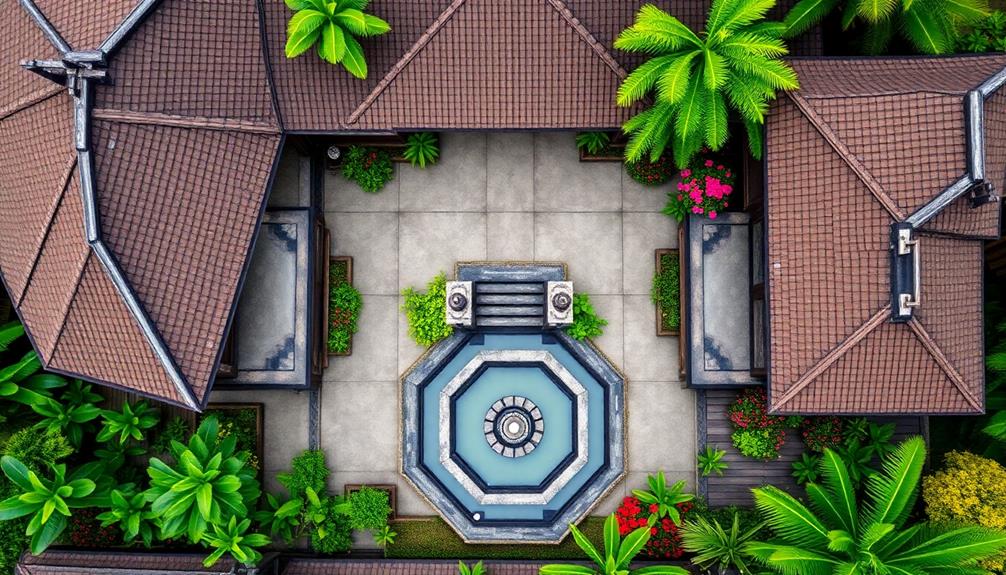
In a typical Balinese house, you'll find a harmonious arrangement of multiple pavilions, each designated for specific activities like living, sleeping, and cooking. This layout promotes open-air living, allowing you to enjoy the beautiful surroundings while maintaining comfort.
Balinese homes often reflect traditional Indonesian housing principles, incorporating elevated structures and local materials to enhance both functionality and aesthetic appeal.
Here are three key features of a Balinese home:
- Pavilions: Each pavilion serves a distinct purpose, fostering a sense of community and privacy. You'll often find a living area, a sleeping space, and a kitchen, all thoughtfully positioned around the compound.
- Central Courtyards: These areas often feature lush gardens or tranquil water elements, providing communal gathering spaces where family and friends can connect. It's a perfect spot to unwind and appreciate nature.
- Natural Materials: Constructed with wood, bamboo, and stone, Balinese homes reflect the local landscape and cultural heritage. These materials not only enhance the aesthetic but also promote harmony with nature.
The pathways connecting the pavilions facilitate movement while ensuring privacy, creating a seamless blend of indoor and outdoor spaces that define the beauty of Balinese architecture.
Color Schemes in Balinese Interiors
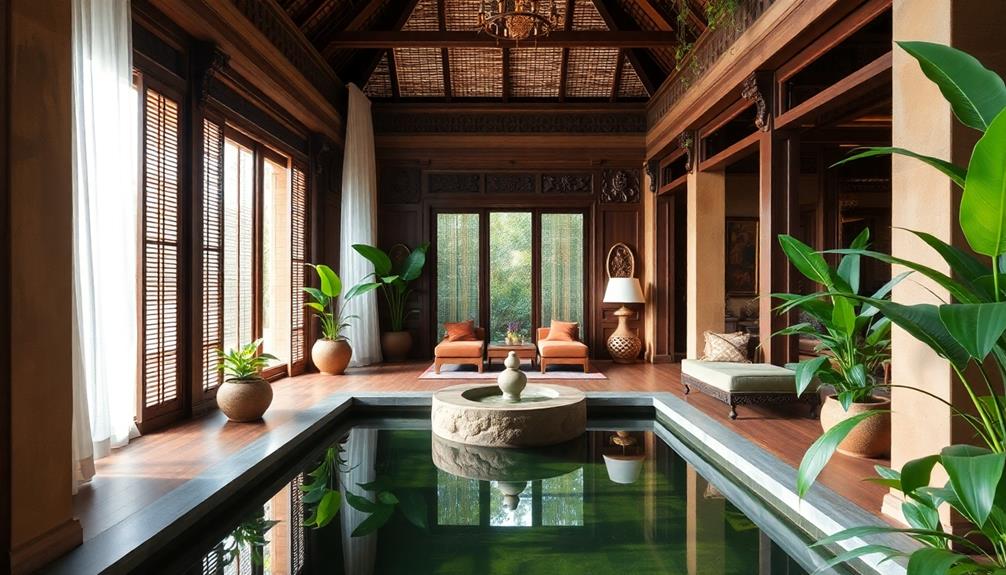
The serene beauty of Balinese interiors is largely defined by their color schemes, which draw inspiration from the natural environment. The Balinese color palette prominently features earthy tones like whites, browns, and greens, evoking a sense of calm and a deep connection to nature. These colors create a tranquil atmosphere that encourages relaxation and well-being.
To enhance the overall aesthetic, incorporating elements such as vibrant floral displays can further enrich the space with cultural significance. To add vibrancy and cultural significance, you'll often find vibrant accent colors such as deep reds, yellows, and blues. These hues inject energy into the space, reflecting the rich traditions of Balinese culture. In this instance, white symbolizes purity and spiritual balance, while black represents wisdom and grounding, further enhancing the overall design.
Natural hues inspired by the surrounding landscapes play an essential role as well. For instance, terracotta brings earthiness, and shades of green mimic the lush flora, reinforcing that connection with nature.
Natural Materials and Textures
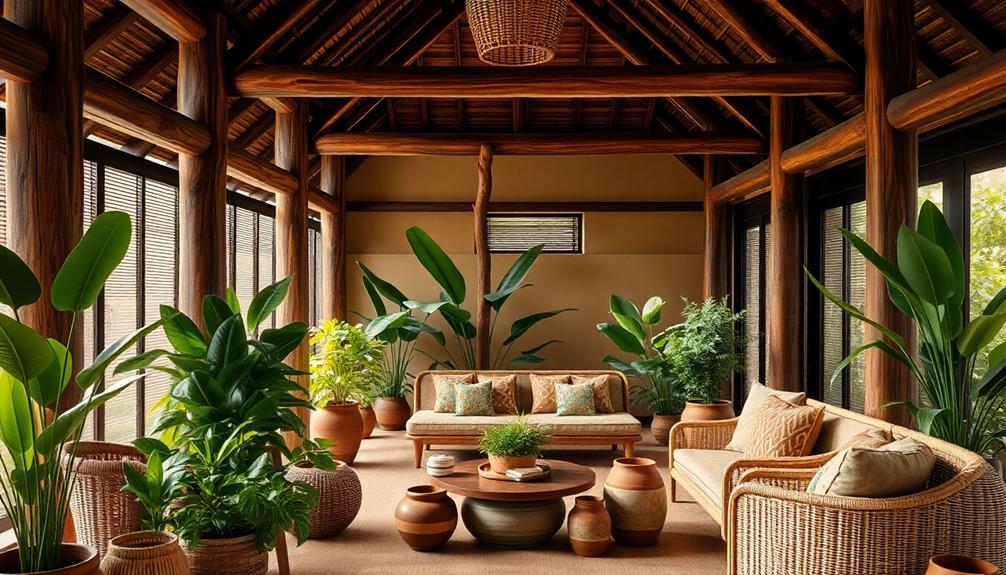
A key aspect of creating a Balinese-inspired interior lies in the use of natural materials and textures that foster a sense of tranquility. Incorporating these elements helps you connect with the lush landscapes of Bali while enhancing the calming ambiance characteristic of its design.
Here are three essential materials to contemplate:
- Bamboo: This versatile resource is essential in Balinese design, used in everything from construction to decorative items. It adds a tropical aesthetic and showcases sustainability.
- Wooden Furniture: Teak and suar wood are popular choices, reflecting Bali's natural beauty with their warm textures and durability. They seamlessly blend comfort and elegance in your space.
- Natural Stone: Volcanic rock and river stone are often used for flooring and accents, providing an organic feel that complements other natural materials.
Enhancing Serenity With Nature
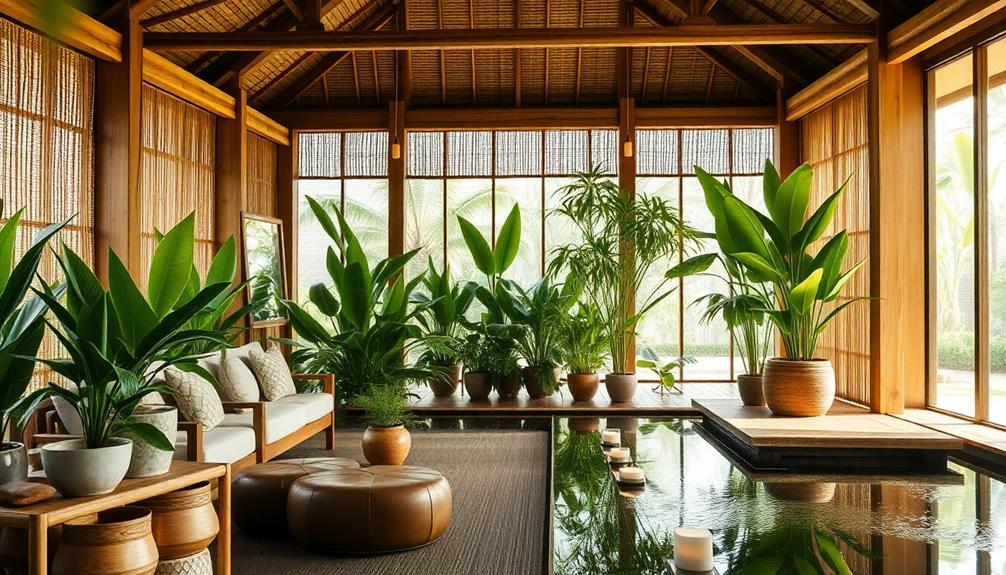
Creating a serene retreat at home hinges on your ability to blend nature with design. By incorporating elements like natural materials, indoor plants, and water features, you'll create a peaceful atmosphere that evokes the tranquility of Bali.
Consider these essential components for enhancing serenity:
| Element | Benefits |
|---|---|
| Natural Materials | Reflects nature, creating harmony |
| Indoor Plants | Purifies air and adds visual interest |
| Water Features | Provides calming sounds and relaxation |
| Open-Air Spaces | Maximizes light and airflow |
| Earthy Colors | Promotes a calming effect |
Using materials like wood, stone, and bamboo, your space will feel warm and inviting. Incorporating indoor plants like palms and ferns not only beautifies your environment but also connects your living area to the natural world. Open-air spaces and large windows are vital for maximizing natural light, allowing a seamless flow between indoors and outdoors.
Incorporating Cultural Influences

Incorporating cultural influences into your interior design can transform your space into a vibrant reflection of Balinese heritage.
By embracing Balinese design elements, you'll create an inviting atmosphere that honors the region's cultural and spiritual traditions.
Here are three ways to weave traditional Balinese motifs into your interior decorating:
- Artistic Textiles: Use batik and ikat textiles to dress your furniture and décor. These fabrics not only add depth and texture but also celebrate the artistry of Balinese weaving traditions.
- Symbolic Artifacts: Integrate handcrafted pottery and ceramics into your design. These pieces often feature intricate designs that tell stories and showcase local craftsmanship, adding a personal touch to your space.
- Focal Sculptures: Incorporate traditional Balinese sculptures and wooden carvings as focal points in your design. Choose pieces that depict mythological themes or honor deities, reinforcing the cultural significance of your décor.
Practical Tips for Implementation
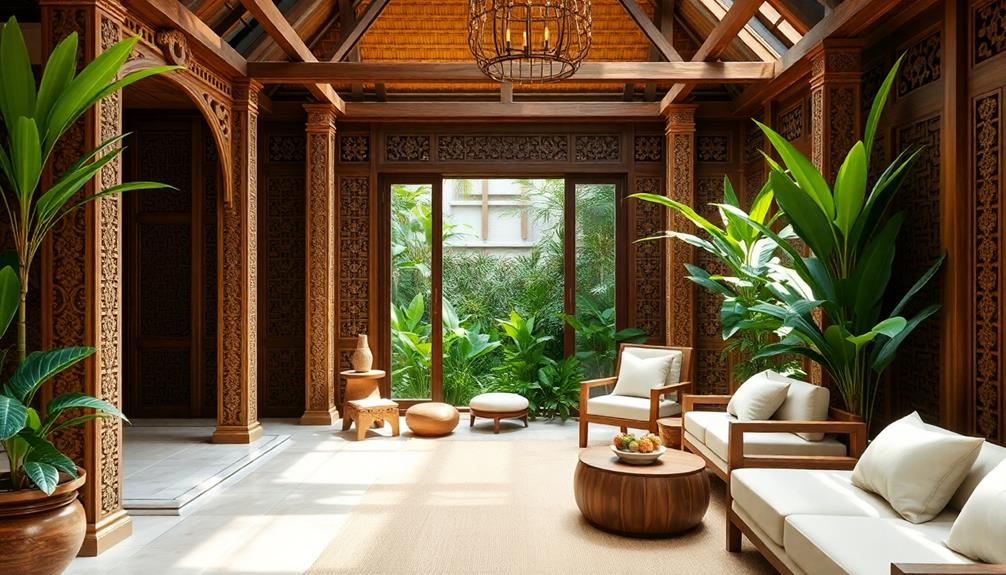
To truly embrace Balinese design in your home, practical implementation is key. Start by incorporating natural materials like teak, bamboo, and stone in your furniture and decor. This creates an authentic Balinese atmosphere that promotes warmth and a connection to nature.
Utilize large windows and sliding doors to blur the lines between indoor and outdoor spaces, maximizing natural light and airflow for a serene living environment.
Next, embrace a neutral color palette featuring earthy tones such as browns, greens, and soft neutrals. You can add vibrant accents through accessories like cushions and traditional Balinese artwork to infuse cultural depth.
Don't forget to include plants and greenery throughout your space; they enhance the natural feel and bring life into your home.
Consider adding water features like indoor ponds or fountains to promote tranquility and reflect Balinese design principles.
Finally, select handcrafted decorative elements such as traditional sculptures and textiles to infuse your interior spaces with cultural significance and artistry.
Frequently Asked Questions
What Is Balinese Interior Design Style?
Balinese interior design style blends natural materials like wood and stone, creating a warm atmosphere. You'll find open spaces, earthy colors, and rich textiles, emphasizing harmony with nature and enhancing tranquility in your living environment.
What Are the Principles of Balinese Design?
You might think Balinese design's just about aesthetics, but it's rooted in harmony and balance. Embrace natural elements, open spaces, and earthy tones to create serene environments that reflect deep cultural connections and tranquility.
What Is the Balinese Design Element?
Balinese design elements include natural materials like wood and stone, intricate carvings, vibrant textiles, and serene water features. You'll find open spaces that invite nature indoors, creating a harmonious atmosphere that feels both calming and inviting.
How to Make Furniture Look Balinese?
Imagine a serene oasis; to evoke that vibe, incorporate hand-carved teak furniture, vibrant textiles, and natural materials like bamboo. Mix comfort and functionality, ensuring your space feels relaxed, inviting, and deeply rooted in tradition.
Conclusion
Incorporating Balinese design motifs into your interiors can transform your space into a tranquil haven. Imagine stepping into a room where warm earth tones blend with natural textures, and soft, flickering candlelight dances on intricately carved wooden accents. The gentle rustle of bamboo leaves outside your window invites nature in, creating a serene atmosphere. By embracing these elements, you'll not only enhance your surroundings but also cultivate a sense of peace and harmony that feels like a tropical retreat.

